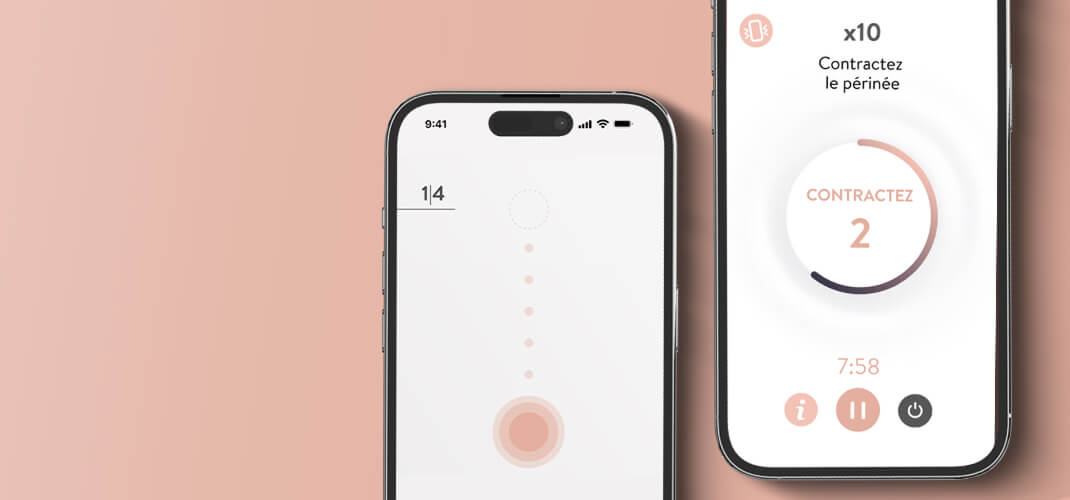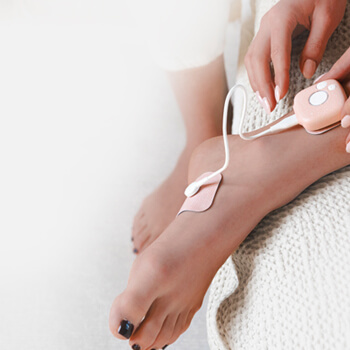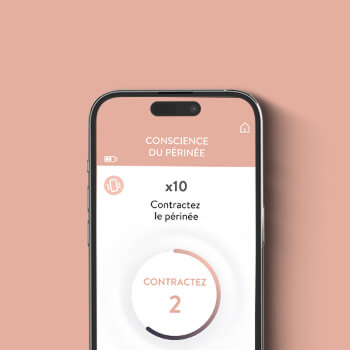Discover the Pinktens solution
Electrical stimulation (no internal probe)
Kegel exercises
Diaphragmatic breathing
How does it work?
Building on existing studies and after conducting hospital-based tests, we have developed a complete probe-free pelvic floor rehabilitation protocol. By placing two electrodes on the ankle to stimulate the tibial nerve pathway, Pinktens works by triggering reflex contractions of the muscles, helping to tone and strengthen the pelvic floor.
The result: Electrostimulation combined with Kegel exercises ensures a strong pelvic floor to lift and support the organs in place.
When to start?
Whenever you feel the need, and in agreement with your doctor
How often?
Once a day; a calendar guides your sessions.
Programme length?
Just over 4 months

6 pelvic floor rehabilitation protocols

Probe-free Electrostimulation

Kegel exercises

Diaphragmatic breathing

Community: support, advice and mutual help

Blog: women’s health, confidence and wellbeing

6 pelvic floor rehabilitation protocols

Probe-free Electrostimulation

Kegel exercises

Diaphragmatic breathing

Community: support, advice and mutual help

Blog: women’s health, confidence and wellbeing
- Certified medical device
- Clinically tested device and protocols
- Noticeable results in just 3 weeks
- Certified medical device
- Clinically tested device and protocols
- Noticeable results in just 3 weeks
Common Questions
For all women suffering from organ prolapse who wish to carry out modern rehabilitation at home. Medical approval is essential before starting any pelvic floor training.
Pelvic floor rehabilitation with Pinktens combines three complementary approaches: External electrostimulation: gentle impulses stimulate the pelvic muscles without voluntary effort. Kegel exercises: targeted contractions to strengthen the pelvic floor. Diaphragmatic breathing: improves coordination and reduces abdominal pressure. This complete method progressively strengthens and tones the pelvic floor in an effective way.
Nothing could be simpler! Sit comfortably and plan a calm activity for about 20 minutes (browse the blog or our Instagram account, for example!) Open the App and choose the new or ongoing protocol Start the day’s program Place the electrodes following the photo placement guide Start the program and let Pinktens do the work!
No. Electrostimulation or Kegel exercises cannot reposition organs that have already descended. However, these techniques help tone and strengthen the muscles that support the organs, which can reduce the feeling of heaviness and provide greater support—helping to prevent the prolapse from worsening, especially from the very first signs.
Do not use Pinktens, or seek medical advice first, in the following cases: - You are pregnant - You have a pacemaker - You have type 2 diabetes with sensory impairment - You have recurrent, undiagnosed pain - You have metallic implants in your body (except dental fillings and IUDs) - You gave birth less than 6–8 weeks ago and have not been medically cleared to start rehabilitation - You have had recent pelvic floor surgery – seek your surgeon’s advice When in doubt, contact us!
Why is good pelvic floor support essential in cases of prolapse?
The pelvic floor is a group of muscles and ligaments located at the base of the pelvis. It acts like a natural “hammock” that supports the organs (bladder, uterus, rectum). When these supporting muscles weaken, the organs tend to descend: this is prolapse.
- Limit the progression of prolapse
- Reduce its impact on daily life
- Improve quality of life
- Prevent other disorders
